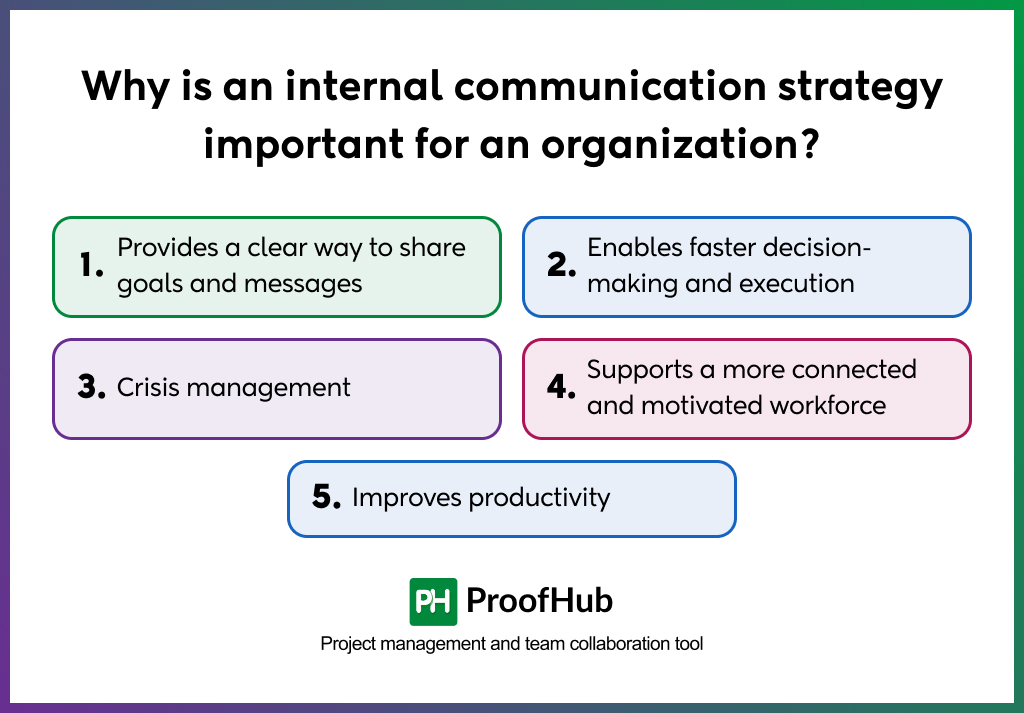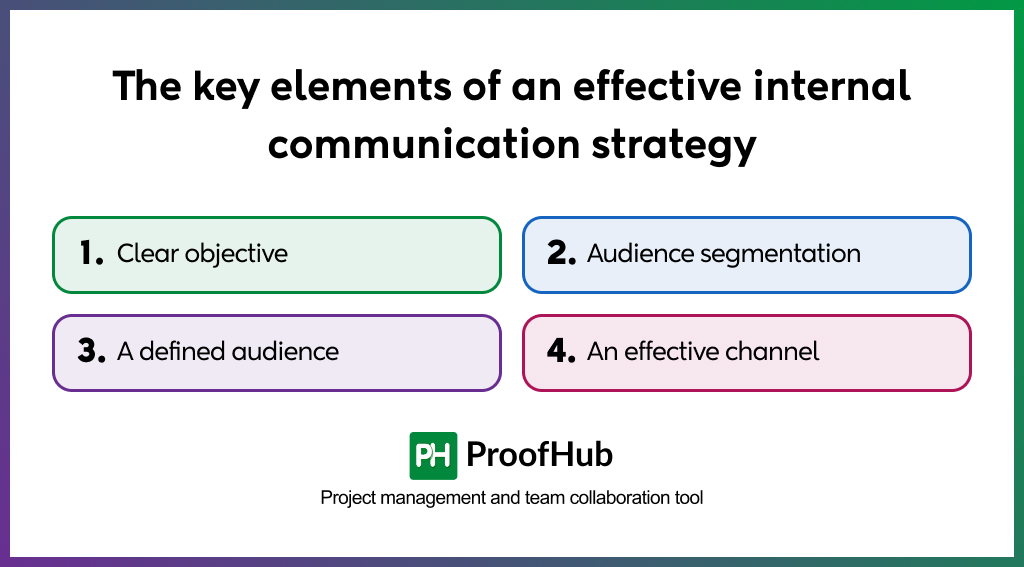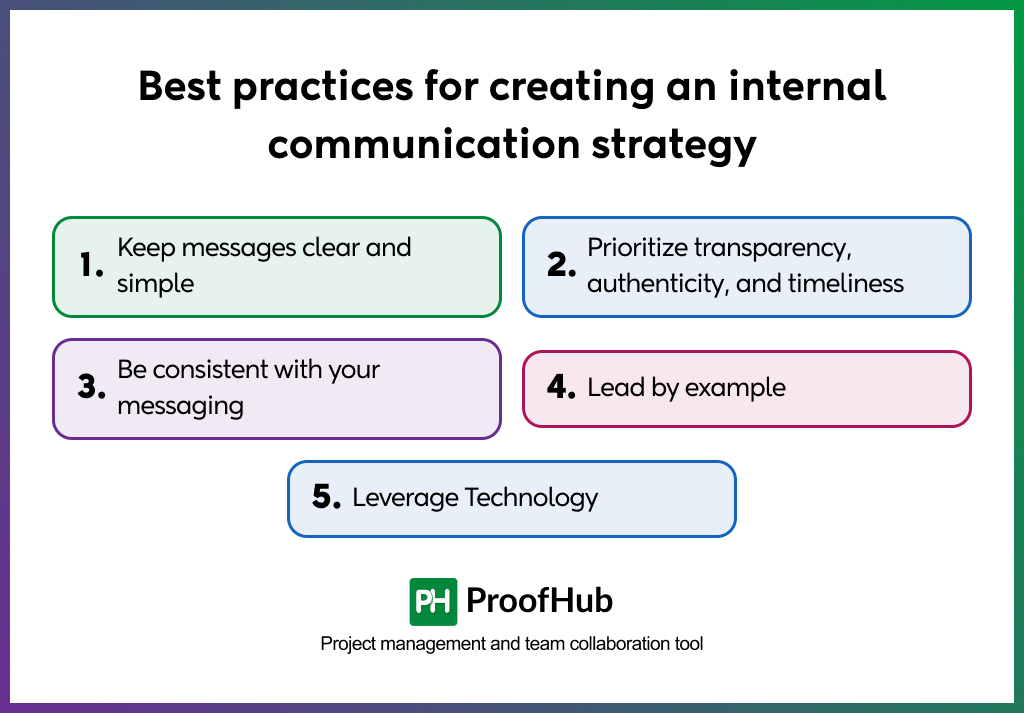Effective internal communication is the backbone of the success of any organization. It does not happen without conscious and consistent efforts. Organizations need to define the internal communication strategy and build an effective internal communication plan to implement those efforts to ensure effective communication.
You probably know the story of Wells Fargo: millions of fake accounts were made, billions in fines were paid, and the CEO stepped down. Many experts believe this whole mess could have been avoided if Wells Fargo had simply talked better inside their own company.
And Wells Fargo isn’t alone. Take Yahoo, for instance — the company delayed internal reporting of major data breaches, which caused confusion, eroded employee trust, and impacted its acquisition deal with Verizon.
Time and again, we see the same thing: when a company struggles to communicate with its own employees internally, big problems often pop up and lead to total disaster.
One thing I learned from these incidents is that internal communication is not just about updates. It is how goals are understood, decisions are executed, and trust is built across every level of your organization. It’s not even wrong to say it’s about shaping your entire organization’s destiny.
Recognizing the importance of internal communication in the workplace, I wrote this blog. You will find seven practical strategies for building an effective internal communication plan, along with key components, best practices, and real-world examples to help you implement it successfully.
What is an internal communication strategy?
An internal communication strategy is a structured and deliberate plan that defines how information flows within an organization. It is more like a structured plan ensuring that the right people get the right information at the right time and in the right way.
Think of it like this: managing a project without a communication strategy is like trying to build something with your team without sharing the blueprint. Everyone may be working hard, but on different tasks, with different priorities, and in different directions.
With a clear communication strategy, it’s like handing out the same blueprint to every team member. Everyone knows what to do and who to talk to if something changes. The result? Fewer delays, fewer misunderstandings, and better results.
Why is an internal communication strategy important for an organization?
Effective internal communication is a crucial part of any successful business. It supports nearly every function within an organization and brings a range of benefits, including:

1. Provides a clear way to share goals and messages
An internal communication strategy gives leaders a reliable way to share goals, updates, and key messages across the company. With this clarity, employees understand what’s expected of them, how their work connects to the bigger picture, and why certain decisions are being made.
It also plays a key role in aligning employees with business goals. When everyone receives the same information and understands the company’s direction, they’re more likely to move in the same direction.
2. Enables faster decision-making and execution
A strong internal communication strategy helps avoid delays by making sure everyone knows who to go to, what decisions they can make, and where to find the information they need. When your team isn’t stuck waiting, they can move forward with confidence and adjust to changing priorities quickly.
3. Crisis management
As a leader, how you communicate during a crisis can shape how your team reacts and how your company recovers. A strong internal communication strategy allows you to take control of the crisis, reduce panic, and keep everyone aligned.
Instead of letting rumors or confusion spread, you can provide clear, timely updates that explain what’s happening, what actions are being taken, and what’s expected from the team.
4. Supports a more connected and motivated workforce
People want to feel connected to the company they work for, not just through goals but through shared values, stories and wins. An internal communication strategy helps leaders build this connection by regularly sharing updates that go beyond tasks, like team achievements or company milestones.
5. Improves productivity
When communication is clear and consistent, teams spend less time searching for information and more time getting meaningful work done. This proactive approach keeps tasks moving forward without unnecessary delays, leading to a more efficient and productive workforce.
What are the key elements of an effective internal communication strategy?

1. Clear objective: An internal communication strategy must have a clear objective. Without it, messages can feel random and fail to create any real impact.
2. Audience segmentation: Your employees aren’t a monolith; tailor your messaging for different team roles or even individuals. For example, your engineers may prefer detailed updates, while your sales team might thrive on quick and actionable insights.
3. A defined audience: Every internal communication strategy must start with a clear understanding of the audience. Without knowing who the message is for, it’s impossible to ensure relevance, clarity, or impact.
4. An effective channel: The way you deliver your message matters just as much as the message itself. Choosing the right internal communication channel ensures your message reaches employees clearly and efficiently. Whether it’s email, messaging apps, or team meetings, the channel should match the purpose of the communication.
7 Steps to create an effective internal communication strategy
Establishing a good communication strategy significantly improves the probability of organization success. Here are seven steps to creating an internal communication strategy:

1. Assess your current communication strategy
The first step to building an effective internal communication strategy is to assess your current strategy. Here are three common situations you may find themselves in:
- You don’t have an internal communication strategy at all.
- You have one, but it’s not working as expected.
- You created a strategy when there were 30 team members, but now the company has grown to 300, and it no longer fits your current needs.
In any of these situations, the goal is the same: get a clear picture of what’s working, what’s missing, and where communication tends to break down.
Look at how messages are currently shared, which tools are being used, and how employees respond. Talk to teams to identify pain points and opportunities for improvement. Ask them questions
- Do you feel informed about what’s happening in the company?
- Are you getting the information you need to do your job well?
- Which channels or tools work best for you, and which ones don’t?
- Where do you feel communication breaks down the most?
To know more about your current communication plan, you can also use following techniques:
Group interviews or focus groups: Bring employees together to discuss how communication feels from their side. These conversations often reveal patterns and frustrations that a survey might miss.
Manager feedback loops: Your managers are a great source of insight. Ask them how communication flows within their teams and what obstacles they face when passing on information.
This first step gives you the insights you need to build a strategy that fits your current team, culture, and company size. Once you know where you stand, you can make intentional changes that truly improve how your organization communicates.
2. Set communication goals and/or define objectives
Use the data and feedback you gather from step 1 to establish a set of goals for your comms strategy. Know what you want your strategy to achieve—whether it’s to improve day-to-day workflows, align teams with long-term goals, or strengthen your company culture.
Defining this purpose gives your strategy direction and helps you focus on what matters most.
There are multiple ways available to set the goals. One of the popular methods is SMART Goals, which stands for:
- Specific: Be clear about what you want to achieve.
- Measurable: Make sure you can track progress.
- Achievable: Set realistic and attainable goals.
- Relevant: Align your goals with broader business objectives.
- Time-bound: Set deadlines to keep things moving.
With the SMART goals approach, you can not only set realistic goals but also ensure that your team members can achieve those goals.
You can also try other goal-setting methods, such as the 5 W’s and How approach, which helps you define the purpose and scope of your communication goals:
- Who needs the information?
- What do they need to know?
- When should the message be delivered?
- Where should the communication take place (what channel)?
- Why is this communication important?
- How will the message be shared and followed up?
This method is especially useful when planning communication for specific initiatives, like launching a new tool or rolling out a company-wide policy.
Whether you use SMART goals or the 5 W’s and How, the key is to give your communication strategy a clear direction.
3. Define the target audience
It’s particularly important when creating an internal communication action plan to understand who the recipient of the message is. This knowledge helps to tailor the content, tone, and delivery method to ensure the message is relevant, engaging, and effectively received by all employees.
Here’s how to define your target audience:
- Talk to team leads or department heads
Managers often have the best insights into what their teams care about, struggle with, or need more clarity on. Use their input to understand what kind of communication works best for each group.
- Categorize your audience
You can also categorize your audience based on their roles or levels within the organization. For example, senior leadership, such as CEOs and directors, may need high-level strategic updates, while middle management, like team leads and project managers, often require detailed operational plans and timelines. Technical staff such as engineers and developers may prefer straightforward, task-focused communication that gets to the point quickly.
4. Choosing the right internal communication tool
After knowing your audience, you have to choose the internal communication tool that will align with your organization needs. These tools provide your team with a central and secure place to communicate and collaborate within the organization. Here is how you can choose the right internal communication tool for your organization:
- Start by analyzing your needs. Do you prefer chat over email? Do you need a tool that offers project management as well?
- Match the tool to your communication goals. Do you want fast, real-time conversations? Look for built-in chat or instant messaging. If you need structure updates? Opt for a tool with announcements or discussion threads.
- Ensure the tool is scalable. Remember, what works for 10 team members might not work for 100.
If you’ve used communication tools before, check the analytics. Which teams open emails, join meetings, or respond to updates regularly? Use this data to refine your approach.
The best internal communication tool is the one that is easy to navigate, doesn’t require weeks of training, and integrates well with other tools your team already uses.
Most tools offer free trials. Use that period to involve team members, test key features, and gather feedback.
We use ProofHub as an internal communication tool. It’s an all-in-one project management and team collaboration software that helps you streamline your team communication with various dedicated channels, eliminating the need for scattered emails, discussion threads, and multiple tools.
5. Create clear and consistent messages
Not all employees need the same level of detail, frequency, or messaging. To keep communication relevant and impactful, it’s helpful to segment your audience into clear groups based on role, seniority, or department.
For example, senior leadership needs business performance reports, but they don’t need daily task-level updates. Managers and team leads, on the other hand, require clear insights into team performance, but not in-depth discussions of the company vision every day. Meanwhile, technical staff typically require updates related to project scope, timelines, system changes, and access to tools.
Segmenting your audience this way helps you decide what information is needed for which department, or it will also help you to deliver right information to the right employee.
Each time you communicate, consider:
- Is this information useful for everyone receiving it
- Does the message include the right context to help people understand it?
- Does this support and reflect our company’s mission, vision, or values?
No matter who you are talking to, whether it’s a manager or team member, everyone should easily understand the message, why it matters, and what action they need to take.
Start by making sure everyone knows:
- Which channel to use for different types of communication ways (e.g., chat for quick updates, announcements for company-wide news, discussion boards for team ideas)
- Where to find important information, like project updates or company goals.
- How to respond, share feedback, or ask questions if they need help or want to contribute.
6. Support and train your team members
Even the best communication strategy will fall short if your employees dont know how to use the tools or what is expected of them. That‘s why it is important to support and train your workforce as part of your internal communication plan.
Start with basic training on how to use internal tools through short sessions, simple how-to guides, or quick explainer videos. But don’t stop there. Also, focus on soft skills training, such as how to give and receive feedback, how to communicate clearly in writing or meetings, and how to handle conflict professionally.
7. Measure and improve
Once your plan is in motion, it’s important to monitor the results. Don’t worry if you’re not hitting every target in the first review. That’s completely normal. It may mean your goals were a bit too ambitious or that a few small adjustments are needed to get things back on track. The key is to learn from the results and keep improving.
Look at how your team is responding to the communication.
- Are they engaging in discussions?
- Are projects running more smoothly because of clearer updates?
- You can use feedback, engagement metrics, and regular check-ins to see what’s working and what’s not.
- You can send short surveys, ask managers for input, or track tool usage to gather insights. Your internal communication tool will help you collect helpful information.
Based on the gathered insights, here are a few ways you can start making your internal communication more effective:
- If people aren’t reading or understanding your updates, make your communication shorter, clearer, and more focused.
- Tailor messages for different teams or roles so they feel more relevant and useful.
- If feedback shows that communication breaks down at the team level, offer extra support or training to those responsible for passing messages along.
Remember, an internal communication strategy isn’t something you set once and walk away from. As your team grows and the need for organization changes, your strategy should grow with it.
Keep listening, keep learning, and keep improving.
Best practices for creating an internal communication strategy
As you build or improve your internal communication plan, keep these best practices in mind. They will help you create a workplace where people feel informed, involved, and aligned, leading to long-term success.

1. Keep messages clear and simple
Clarity is the backbone of effective internal communication. When messages are cluttered with jargon, overly technical language, or unclear instructions, it creates confusion rather than alignment.
In contrast, clear and simple messaging makes it easier for everyone to stay on the same page. It helps reduce misunderstandings, aligns expectations, and allows information to move across teams more efficiently.
2. Prioritize transparency, authenticity, and timeliness
Every internal message should aim to support, inform, or empower your team. Whether it’s a quick update or a major announcement, it should add real value, never just fill space.
Be open and honest in what you share. Employees appreciate transparency and are more likely to trust leadership when communication feels real, not polished or overly filtered.
3. Be consistent with your messaging
Consistency is key to building trust and reinforcing important messages. When communication is scattered or constantly changing in tone or content, it becomes difficult for employees to follow or take action confidently.
Stick to a regular cadence, use familiar language, and align your messages with your company’s goals and values. This helps everyone stay grounded and avoids confusion.
4. Lead by example
The way leaders communicate directly influences the communication culture across the organization. If you want teams to be open, honest, and responsive, start by doing it yourself.
Show up in conversations, acknowledge feedback, and share updates proactively. When leadership models strong communication habits, employees are more likely to engage and communicate effectively, too.
5. Leverage Technology
The right tools can make or break your internal communication efforts. Using user-friendly platforms helps your messages reach the right people at the right time—without the noise or delays caused by outdated or disconnected systems.
For example, tools like ProofHub combine project management and internal communication in one place, making it easier for teams to collaborate, stay informed, and get work done—all without juggling multiple apps.
Discover top 11 ways to improve internal communication in the workplace
Examples of internal communication strategies
1. Golf Town – real-time communication that improves customer engagement
Golf Town, a leading golf retailer in Canada, recognized the importance of empowering frontline employees with timely and relevant information, especially when speaking to passionate customers during major events like the PGA Tour.
To make sure their in-store teams could confidently engage with golf enthusiasts, the company launched an internal communication strategy focused on real-time updates.
Employees received bite-sized, up-to-date facts and figures about tournaments directly on their devices, helping them stay informed and relevant in customer conversations.
2. Walmart – driving safer behavior through interactive internal training
Walmart, one of the world’s largest employers, faced a significant challenge: how to reduce accidents and reinforce a culture of safety across its massive distribution network and private fleet.
To address this, Walmart launched an innovative digital platform tailored for its 75,000 distribution centre employees across 150 locations. Instead of relying on traditional top-down safety briefings, the company used gamified microlearning—short, engaging daily sessions lasting just 3 to 5 minutes.
Each day, employees would log into the platform, answer safety-related questions, and receive immediate feedback. The platform was directly tied to performance metrics, allowing Walmart to track behavior change in real-time.
3. Amazon – Using employee-driven storytelling to strengthen internal and external communication
Amazon faced a competitive hiring environment and needed to stand out—not just with job listings, but with a strong, relatable message about what it’s like to work there. Rather than relying solely on polished corporate content, Amazon turned inward and let its own employees lead the conversation.
To support its Employer Value Proposition (EVP) and attract new talent—especially for its Brand Specialist roles—Amazon empowered employees to share their real experiences through video storytelling. These videos weren’t just testimonials—they were authentic, unscripted looks into what the work involves, how teams collaborate, and what values drive the organization.
- The video was added to Amazon’s careers page, giving candidates real insight into the role.
- It was shared across social media and used in paid advertising campaigns to reach wider audiences.
The results? The video became popular among new joiners, and its launch led to double the click-through rate on Amazon’s jobs page.
What are the challenges in creating an internal communication strategy, and how can they be solved?
Here are some of the common challenges in creating an internal communication strategy, and I will not leave you with the problem. You will find solutions to the challenges here.
1. Resistance to change
Many employees are used to old habits, whether it’s relying on email, staying within team silos, or avoiding open feedback. Introducing a new communication strategy can feel like extra work or unnecessary change.
To tackle this situation, you need to explain the “why” behind the changes. Show them how this new communication plan can save time, reduce confusion, and improve their work experience.
2. Lack of standard communication guidelines
When there are no clear rules or guidelines for how teams should communicate, things quickly get messy. Some people may use project management tools, others might rely on collaboration apps, and a few still send updates through WhatsApp or emails. Without a unified approach, important information gets lost, messages are missed, and teams operate in silos.
This lack of consistency leads to confusion, misalignment, and unnecessary delays. Everyone is doing their own thing, but no one is fully on the same page.
The solution? Establishing standard communication guidelines—defining what to communicate, when, where, and how. And to support those guidelines, using a centralized platform like ProofHub can make a big difference. It brings together all your communication and project-related conversations in one place, reducing tool fatigue and helping teams stay aligned, efficient, and informed.
3. One-way communication culture
When communication only flows top-down, employees may feel unheard or disconnected from decisions. Over time, this can lead to low engagement, lack of trust, and missed opportunities for improvement.
As a leader, you should create an effective communication plan that flows in two directions. Team members also have the right to share their views. You can create Q&A forums, anonymous surveys, or regular feedback sessions. Remember, listening is as important as informing.
4. Differing communication preferences
Everyone has a different way of understanding and responding to information. Some people prefer short and clear text messages, others connect better with visuals like charts or infographics, while some may understand best through face-to-face talks or video updates.
If you only use one method, like long paragraphs or written memos, you might lose the attention of those who prefer simpler, more engaging formats.
To better deliver your message, don’t assume one size fits all. Use a mix of communication formats—written messages, videos, visuals, and live meetings. Ask your team what works best for them and adjust your approach so everyone stays informed and engaged.
Also read: 11 Internal communication challenges and solutions to fix them
Wrapping up
Having a strong internal communication strategy is key to any organization’s success. When everyone from leadership to frontline employees clearly understands what’s happening and what’s expected, they can stay focused, productive, and more motivated in their roles.
But there’s no one-size-fits-all approach. What works well in one company may not work in another. The most effective communication strategies are those that match your company’s culture, team structure, and business goals.
Tools like ProofHub can make this easier. It brings collaboration and project management into one place so your team stays connected without needing multiple tools.
Organize your business communications and management using ProofHub. One tool for all professionals.
Frequently asked questions
What are the types of internal communication?
1 Top to bottom (Leader-to-employee)
This is the traditional way of communication where information flows from top to bottom. Leaders share important updates, company goals, policies, or instructions with employees.
2 Bottom to top (Employee-to-leader)
This is about giving your team members a voice. They can share their views, ideas, and goals with managers and others higher up in the company hierarchy.
3. Change management communication
This type of internal communication happens when your organization is going through a change, like adopting a new process, restructuring teams, launching a new product, or shifting company goals.
4. Crisis management communication
This comes into play when your organization faces a serious issue, such as a security breach, public backlash, financial trouble, or a natural disaster. In these moments, how leaders communicate internally can shape how employees respond.
What is the role of leadership in creating an internal communication strategy?
Leadership plays a critical role in shaping and executing a successful internal communication strategy. Leaders set the tone for communication across the organization. Their involvement is essential in making sure that messages are aligned with the company’s vision, values, and goals.
How do you measure the effectiveness of your internal communication strategy?
You can use your internal communication tools, which are equipped with reporting and details that allow you to measure the effectiveness of your internal communication.
Here are key ways to measure effectiveness:
- Manager Input: Regular check-ins with team leads can reveal patterns—like common misunderstandings, missed updates, or bottlenecks.
- Engagement Metrics: Track open rates on emails, participation in meetings or forums, and responses in feedback channels.
- Employee Feedback: Use surveys, polls, and suggestion boxes to ask employees how they feel about internal communication—what works and what doesn’t.

